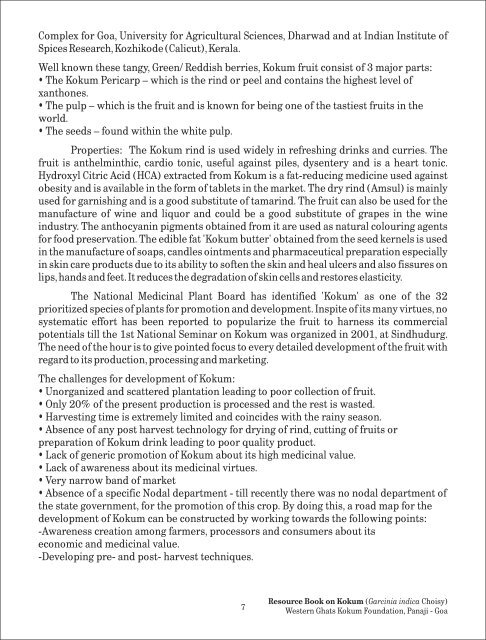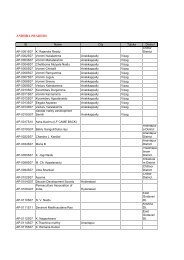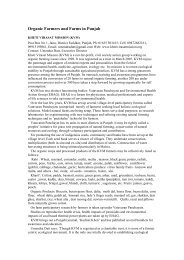Western Ghats Kokum Foundation - Organic Farming Association of ...
Western Ghats Kokum Foundation - Organic Farming Association of ...
Western Ghats Kokum Foundation - Organic Farming Association of ...
Create successful ePaper yourself
Turn your PDF publications into a flip-book with our unique Google optimized e-Paper software.
Complex for Goa, University for Agricultural Sciences, Dharwad and at Indian Institute <strong>of</strong><br />
Spices Research, Kozhikode (Calicut), Kerala.<br />
Well known these tangy, Green/Reddish berries, <strong>Kokum</strong> fruit consist <strong>of</strong> 3 major parts:<br />
• The <strong>Kokum</strong> Pericarp – which is the rind or peel and contains the highest level <strong>of</strong><br />
xanthones.<br />
• The pulp – which is the fruit and is known for being one <strong>of</strong> the tastiest fruits in the<br />
world.<br />
• The seeds – found within the white pulp.<br />
Properties: The <strong>Kokum</strong> rind is used widely in refreshing drinks and curries. The<br />
fruit is anthelminthic, cardio tonic, useful against piles, dysentery and is a heart tonic.<br />
Hydroxyl Citric Acid (HCA) extracted from <strong>Kokum</strong> is a fat-reducing medicine used against<br />
obesity and is available in the form <strong>of</strong> tablets in the market. The dry rind (Amsul) is mainly<br />
used for garnishing and is a good substitute <strong>of</strong> tamarind. The fruit can also be used for the<br />
manufacture <strong>of</strong> wine and liquor and could be a good substitute <strong>of</strong> grapes in the wine<br />
industry. The anthocyanin pigments obtained from it are used as natural colouring agents<br />
for food preservation. The edible fat '<strong>Kokum</strong> butter' obtained from the seed kernels is used<br />
in the manufacture <strong>of</strong> soaps, candles ointments and pharmaceutical preparation especially<br />
in skin care products due to its ability to s<strong>of</strong>ten the skin and heal ulcers and also fissures on<br />
lips, hands and feet. It reduces the degradation <strong>of</strong> skin cells and restores elasticity.<br />
The National Medicinal Plant Board has identified '<strong>Kokum</strong>' as one <strong>of</strong> the 32<br />
prioritized species <strong>of</strong> plants for promotion and development. Inspite <strong>of</strong> its many virtues, no<br />
systematic effort has been reported to popularize the fruit to harness its commercial<br />
potentials till the 1st National Seminar on <strong>Kokum</strong> was organized in 2001, at Sindhudurg.<br />
The need <strong>of</strong> the hour is to give pointed focus to every detailed development <strong>of</strong> the fruit with<br />
regard to its production, processing and marketing.<br />
The challenges for development <strong>of</strong> <strong>Kokum</strong>:<br />
• Unorganized and scattered plantation leading to poor collection <strong>of</strong> fruit.<br />
• Only 20% <strong>of</strong> the present production is processed and the rest is wasted.<br />
• Harvesting time is extremely limited and coincides with the rainy season.<br />
• Absence <strong>of</strong> any post harvest technology for drying <strong>of</strong> rind, cutting <strong>of</strong> fruits or<br />
preparation <strong>of</strong> <strong>Kokum</strong> drink leading to poor quality product.<br />
• Lack <strong>of</strong> generic promotion <strong>of</strong> <strong>Kokum</strong> about its high medicinal value.<br />
• Lack <strong>of</strong> awareness about its medicinal virtues.<br />
• Very narrow band <strong>of</strong> market<br />
• Absence <strong>of</strong> a specific Nodal department - till recently there was no nodal department <strong>of</strong><br />
the state government, for the promotion <strong>of</strong> this crop. By doing this, a road map for the<br />
development <strong>of</strong> <strong>Kokum</strong> can be constructed by working towards the following points:<br />
-Awareness creation among farmers, processors and consumers about its<br />
economic and medicinal value.<br />
-Developing pre- and post- harvest techniques.<br />
7<br />
Resource Book on <strong>Kokum</strong> (Garcinia indica Choisy)<br />
<strong>Western</strong> <strong>Ghats</strong> <strong>Kokum</strong> <strong>Foundation</strong>, Panaji - Goa





